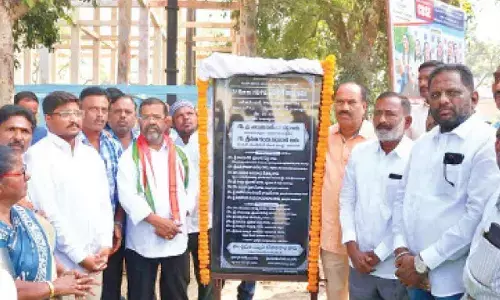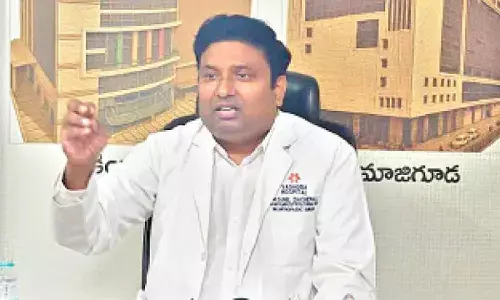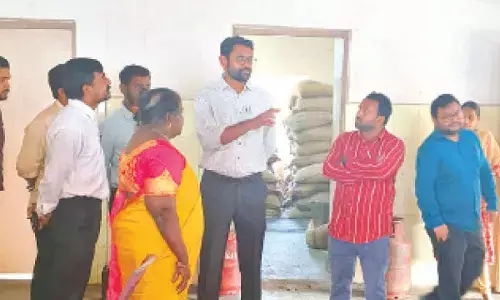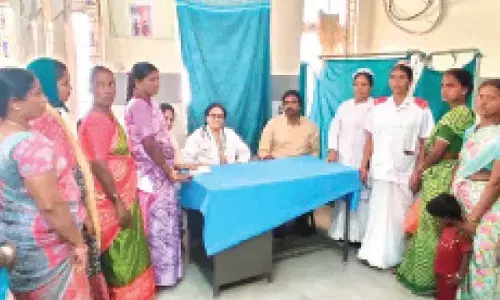Less resource-intensive crops can reduce ryot suicides

Agriculture in Telangana, and also in the country, has been in a precarious condition with low productivity, higher fluctuations and lower profitability, which has been manifesting in the relentless farmers’ suicides.
Agriculture in Telangana, and also in the country, has been in a precarious condition with low productivity, higher fluctuations and lower profitability, which has been manifesting in the relentless farmers' suicides.
In the combined Andhra Pradesh about 40,000 farmers have committed suicides between 1995 and 2014. In Telangana nearly 4,000 farmers have committed suicides since June 2, 2014.
Various studies on farmers' suicides at national and state level have identified several reasons for the plight of the farmers. These include crop failures, bore-well failures, indebtedness, informal credit, non-accessibility of institutional credit, low profitability, over dependence on external inputs- which are mostly costly and generally spurious, marketing, etc.
At the same time, the governments at the centre and state cannot be blamed of negligence of agriculture. Agriculture remained on the top priority of all governments at the centre and state.
The problem lies in the wrong strategies, policies, programmes and projects. The Governments are rolling out inappropriate strategies, polices, plans, programs and projects either due to dearth of knowledge or internal compulsions.
According to the National Crime Records Bureau (NCRB) data, Telangana has experienced 898 and 1,358 farmers' suicides during the first two years of her existence as an independent state.
According to two NGO forums, total number of farmers' suicide in the state between June 2014 and December 2018, is 3,707 (as per www.agrariancrisis.in, henceforth IAC) and 3,660 (according to https://rsvonline.org, henceforth RSV).
As per IAC website, out of total 3,707 suicides, 210 were women farmers. Year wise, highest number of suicides was recorded in 2015 followed by 2014. All three sources of data confirmed the trend (Table 1).
The drought in year 2015, being an extension of 2014 drought, has severely affected the agriculture sector in the state. Its impact can be seen in terms of number of farmers' suicides also. Since then the number of suicides have been declining steadily and significantly.
The State Government's policies and programs are showing positive impact. Restoration of almost all irrigation tanks, building up of a few new tanks, higher investments in, and, speedy completion of, irrigation projects are showing their impact. The drastic reduction in farmers' suicides in 2018 can be attributed to the State Government's novel and bold program - Rythu Bandu.
Yet another possible reason for the steep decline in the farmers' suicides in the state is the cleaning of lands records by the State Government. It may be noted that Jayati Ghosh Commission pointed out that ambiguity in lands ownership records was one of the major reasons for farmers' suicides in the combined Andhra Pradesh.
The State Government has cleaned all land records and handed over clear Pattadar Passbooks to all landowners at their homes, in a mission mode. In the process the state has set a new benchmark in the country.
As Hyderabad district does not have any agriculture and farmers, it is excluded in the analysis.
Among the remaining 30 districts, Nalgonda has highest number of suicides (404) since the formation of the state; followed by Siddipet (319), Warangal Rural (195), Adilabad (171), Jayashankar-Bhoopalapally (168), Medak (164) and so on. At the same time, Medchal district has experienced least number of suicides (10) preceded by Komarambheem (29), Jogulamba (46), Mancherial (51), Nizamabad (73), Suryapet (74), so on.
As per 2011 Census, Telangana has 35.51 lakh cultivators, which is 19 per cent of total workers in the state. In terms of incidence of farmers' suicides, a little more than one farmer committed suicides per every 1,000 farmers (of 2011 census) since the formation of the state.
In other words 116 farmers have lost their lives during 2014-18, per every one lakh cultivators, in the state. By and large the absolute number of suicides, in the districts, reflects in the incidence levels of suicides across the districts, with some notable exceptions.
Districts like Rangareddy, which have relatively higher number of cultivators have relatively less incidence of suicides. On the other hand, districts like Warangal Urban and Peddapalle, with relatively less number of cultivators, have experienced relatively higher incidence of suicides.
Out of total 584 mandals in the state, as many as 504 mandals have experienced farmers' suicides. It implies that farmers' suicides have been occurring across the state in almost all rural and interior mandals.
Out of 504 mandals each of 246 mandals have experienced 1 to 5 suicides; each of another 124 mandals have witnessed 6 to 10 suicides; each of yet another 81 mandals have experienced 11 to 15 suicides; and each of 22 mandals have witnessed 16 to 20. In total 35 mandals have 20 and above farmers' suicides since June 2014.
Mandal wise, highest number of suicides recorded was 37 in Cherial mandal of Siddipet district, preceded by Vikarabad (32), Grrampde (32) and Galwel (32). Among the Assembly Constituencies, Gajwel experienced the highest number of suicides (127), preceded by Husnabad (105), Manthani (97) and Dubbak (97).
It may be noted that 2014 and 2015 were drought years in the state. The drought in year 2015, being an extension of 2014 drought, has severe adverse affect on the agriculture sector in the state.
Its impact can be seen in terms of number of farmers' suicides also. Since then the number of suicides have been declining steadily and significantly. The State Government's policies and programs are showing positive impact.
Restoration of almost all irrigation tanks, building up of a few new tanks, higher investments in, and, speedy completion of, irrigation projects are showing their impact.
The drastic reduction in farmers' suicides in 2018 can be attributed to the State Government's novel and bold programme - Rythu Bandhu. Yet another possible reason for the steep decline in the farmers' suicides in the state is the cleaning of land records by the State Government.
The incidence of farmers' suicides is positively correlated with the incidence of resource intensive crops (cotton and paddy) and practices (number of power connections). On the other hand, a moderate negative correlation was observed between the less resource intensive crops such as Jowar, Groundnuts, Bengal gram, Red gram, Green gram, and farmers' suicides.
Among all the development indicators used in the analysis, the health index has highest negative correlation with the incidence of suicides (-0.5), followed by urbanization (-0.26), non-farm employment (-0.15), gender equity index (-0.15) and district development index (DDI) (-0.21).
Among selected indicators the incidence of fluorosis has highest positive correlation of 0.56 with district wise incidence of suicides. Relatively high positive correlation were found between the district wise incidence of farmers' suicides and incidence of 'mentally retarded persons (0.52), paralysis (0.52), asthma (0.46), deaf and dumb (0.44), AIDS (0.44), Cancer (0.43), heart dieses (0.43), physical disability (0.41), and so on.
Higher incidence of diseases means higher medial expenditure and indebtedness. It also leads to emotional stress and depressions. Higher expenditure on education appears to be one possible reason for the farmers' suicides.
The major problems of present agriculture development policies and programs include: (1) overemphasis on modern technologies and inputs and completely neglecting the indigenous technologies, knowledge and practices; (2) compartmentalization of agriculture development and governance with total disregard to the synergies of integrated development and ecosystem and its services; (3) static and inappropriate subsidies; (4) Too much centralization of resources and decision making and standardized solutions; etc.
The following are a set of suggestions for resolving the fundamental problems of
agriculture sector and farmers distress:
1. Domain expert should head or at least in a decision making position in the ministries and departments.
2. All ministries/ departments dealing with agriculture and allied sector should be merged. At least a perfect coordination at apex level has to be ensured.
3. An integrated farming or simply agro-forestry has to be promoted and facilitated throughout the state and country. It enables an optimum utilization of the temporal and vertical space of the scarce and precious land resource.
Tree based farming model of BAIF, known as Vadi model is the best example for agroforestry. However, tree based farming needs critical facilitation by the government.
These include (1) removal of restrictions on tree growing, harvesting and marketing, (2) critical water supply/ irrigation throughout the year and across the state, (3) prevention of distress youth migration from rural areas, and (4) incentives for tree growing, i.e. carbon credits.
Dr Bhaskara Rao is a Development Professional and Honorary Director of INBI Foundation, Hyderabad and Dr Indrakant is RBI Chair Professor at Council for Social
Development, Hyderabad. Views are personal.










